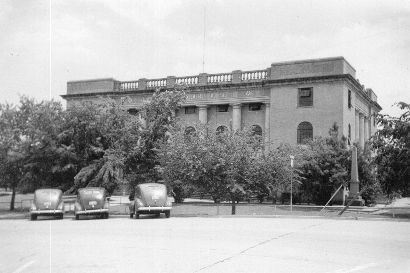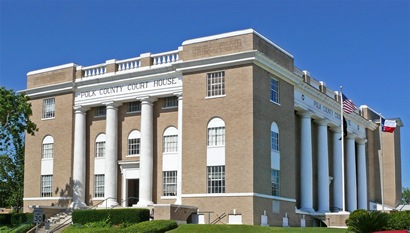|
 |
THE COURTHOUSES
OF POLK COUNTY
by Terry
Jeanson
Early settler Moses L. Choate founded the town of Springfield
near the Trinity River in the Texas Piney Woods in the 1830s. When
Polk County was organized
in 1846, cut from northern Liberty
County, Springfield was chosen as the county seat, not only for
its central location, but because of Choate’s offer of land in exchange
for renaming the town Livingston
after his home town in Tennessee. When San
Jacinto County was organized in 1870, the town of Livingston
found itself on the southwest boundary of the county, but it has remained
the county seat.
The county’s first courthouse was a $10.00, one-room log cabin
built by Texas Revolutionary War veteran John English in 1846.
It was built on a hill where all the subsequent courthouses were built.
This was only meant to be a temporary courthouse. The second courthouse
was completed in 1847 and was a larger, one-story log cabin measuring
26’ x 22’ x 20’. It was built by James Andress, a local civic
leader and innkeeper, at a cost of $347.00. Andress moved the first
courthouse down the hill and attached it to his inn where it was used
as a kitchen. The Andress Inn was demolished in
1911, but a Texas historical marker south of the current courthouse
identifies its former location. The county’s third courthouse
was a 40’ x 40’ two-story structure built of brick in 1854, costing
just under $6,000. Thirty years later, the third courthouse was so
thoroughly renovated, receiving a new stone facade, that a new courthouse
emerged. The renovated 1854 courthouse became the county’s fourth
courthouse in 1884.
It was built of stone and brick and designed by popular Houston
architect Eugene
T. Heiner in his familiar Second Empire style. The renovation
cost $17, 500 and the contractor was W. C. Wells. A white fence was
built around the courthouse square at this time to keep roving livestock
off the grounds. In 1902, downtown Livingston
was destroyed by fire, reportedly caused by a disgruntled liquor salesman
upset with the county’s ban on the sale of alcohol. The 1884 courthouse
was the only downtown building that survived.
Within ten years, the county had outgrown the 1884 courthouse which
led to the building of an annex. In 1905, a 23’ x 43’ courthouse
annex was built of locally made red brick on the southwest corner
of the courthouse square. It was designed by Houston
architect Lewis Sterling Green. The annex
still stands today as the county’s oldest government building. Green
used the same design for the 1908 Trinity County records building
in Groveton which was later incorporated
into the current Trinity
County courthouse designed by the Page Bros. of Austin.
The construction of the county’s fifth and current courthouse
began in 1923. Houston
contractor Isaac Young had cleared the foundation by July and
the cornerstone was laid on November 12, 1923. The brick and concrete
courthouse was built in the Classical Revival style (in the case of
this courthouse, also referred to as Texas Renaissance) with Beaux-Arts
details such as large entrance columns, arched windows, a cross-axial
floor plan and a flat roof with decorative balustrades. The county
hired the Houston architectural
firm of McLelland and Fink to design the building. Born in
Scotland, John McLelland practiced in other areas of the country before
settling in Houston in
1911 where he designed several public schools. He was the city architect
of Houston from 1919-20
and he died suddenly in 1929. Little is known about his partnership
with Fink. This courthouse was the first courthouse for Polk County
to have electricity, indoor plumbing, a furnace for steam heating,
telephones and drinking water from another source other than from
roof run-off. The courthouse was used for political and social functions
and contained a community auditorium, library, post office, American
Legion Hall and a jury dormitory with showers. The building’s total
cost was $178,740 and it was completed in 1924. The first commissioners
court was held on October 6, 1924.
Although still resembling its original exterior configuration, several
changes have been made to this building over the years. When the ceilings
were lowered to add air conditioning ducts in 1957, the top part of
the arched second floor windows were painted white. The frieze displaying
the words “Polk County Court House” was originally buff colored with
white letters but was painted white with black letters in the 1950s.
An exterior elevator shaft was added to the northwest corner in 1968
and more air conditioning units were added in 1970. A proposed restoration
plan includes the return of the building’s original exterior features,
including the removal of the elevator shaft, restoring the lampposts
on the brick pedestals flanking the staircases and restoring the original
oak doors with transoms. On the inside, the original offices would
be restored as would the two-story district courtroom with upper balcony.
Source:
Courthouse information from the Texas Historical Commission County
Atlas at http://atlas.thc.state.tx.us/shell-desig.htm,
National Register of Historic Places - Polk County Courthouse and
1905 Courthouse Annex. Historical information from the Handbook
of Texas Online. |
 |
Polk
County Courthouse
Photo courtesy Jim Evans, 2016 |
The Current
Polk County Courthouse
- Livingston, Texas
Date - 1923
Architect - McLelland and Fink
Style - Texas Renaissance
Material - Concrete and brick |
| "Polk
County courthouse historical marker at the east side entrance"
- Terry
Jeanson |
Historical Marker
POLK COUNTY
COURTHOUSE
Completed in 1924,
this is the fifth courthouse to serve Polk
County. Citing "lack of space and modern conveniences," the Commissioners
Court hired the Houston
architectural firm of McLelland & Fink to design their new building.
Contractor Isaac Young completed demolition of the 1884 courthouse
by July 1923, and the first court meetings were held in this building
by the fall of 1924. Designed to include an auditorium, library, American
Legion hall and post office, which were replaced in later years by
administrative and judicial offices, the Polk County Courthouse features
Classical Revival styling with Beaux Arts influences. It stands as
a significant part of Livingston's architectural heritage.
Recorded Texas Historic Landmark - 2001 |
Polk County courthouse
Photo courtesy Terry
Jeanson, February 2006 |
"Southeast
corner of the courthouse. The community gazebo was completed in 1999.
The cornerstones of the two previous courthouses are supposed to be
displayed at the northeast corner of the grounds."
- Terry
Jeanson, February 2006 photo |
"Northwest
corner of the courthouse, showing the exterior elevator shaft. Railroad
tracks can be seen in the foreground."
- Terry
Jeanson, February 2006 photo |
"North
side entrance to the courthouse. The brick pedestals flanking the
staircase where the flag poles are now once held gas lampposts."
- Terry
Jeanson, February 2006 photo |
Architect - Houston
architect Eugene
T. Heiner
Style - Second Empire style
Material - stone and brick
Contractor - W. C. Wells
Cost - $17, 500
A white fence was built around the courthouse square to keep roving
livestock off the grounds. |
"This
picture of the 1884 courthouse is on a memorial to Polk
County history displayed on the north side of the courthouse."
- Terry
Jeanson, 2006 photo |
1884
Polk County courthouse
Photo courtesy THC |
The 1905 annex
('Campbell-Forman Building') to the 1884 Polk County courthouse, on
the grounds of the current courthouse.
Photo courtesy Terry
Jeanson, February 2006 |
| "This annex
was designed by Houston architect Lewis Sterling Green. Mr. Green
used the same design for the Trinity County records building in Groveton
which was later incorporated into the current Trinity
County courthouse." - Terry
Jeanson |
|
|
